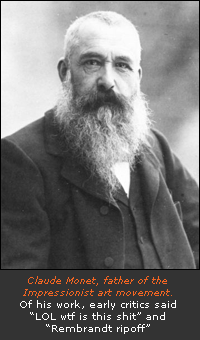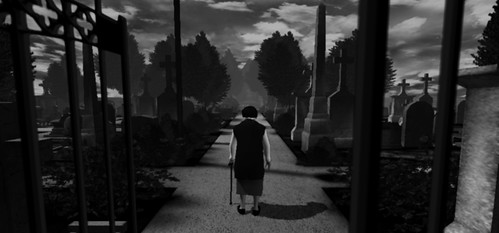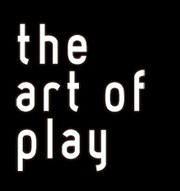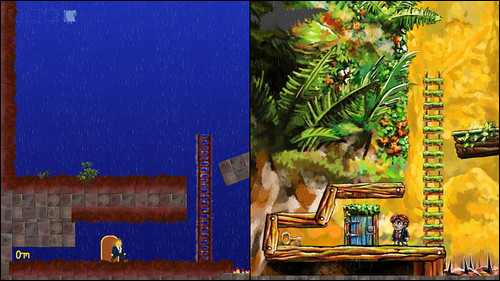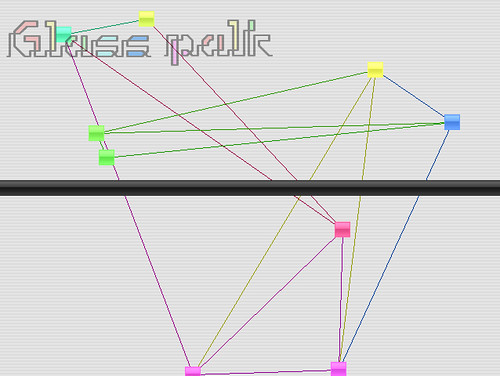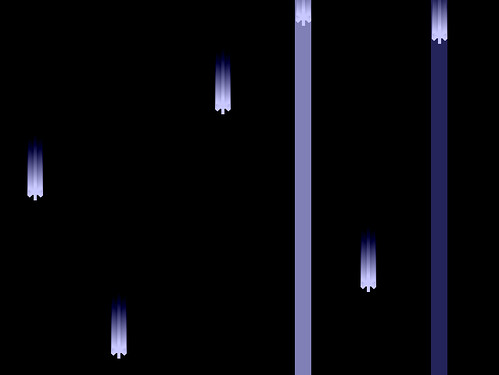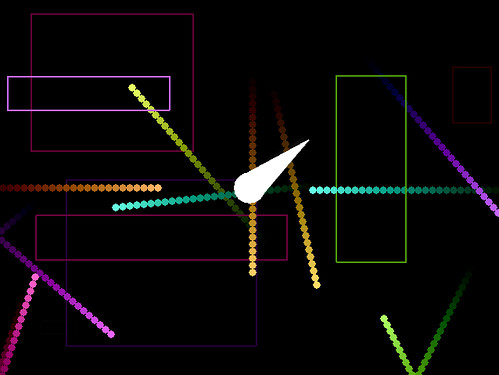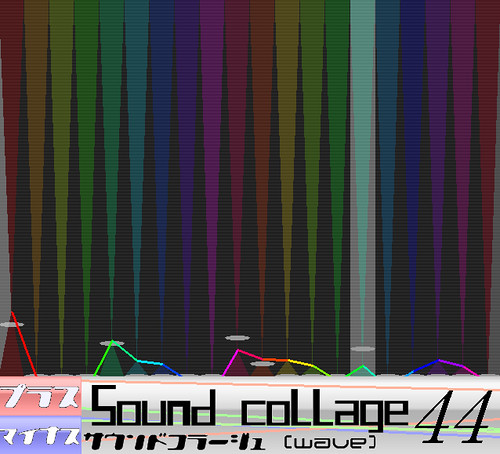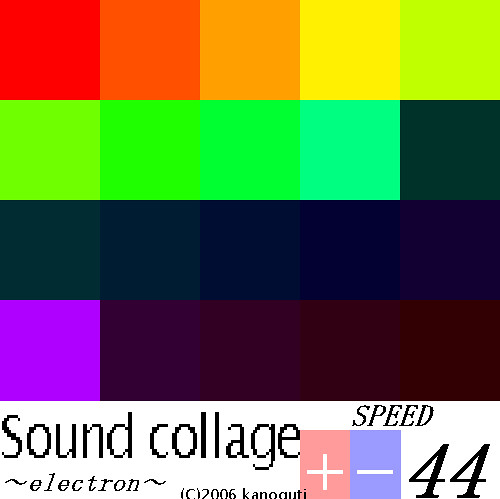Posts from ‘Games and Art?’ Category
Poppenkast: 3 Hours to Fame
By: Derek Yu
On: July 14th, 2008

The Poppenkast have finished their second competition, called “3 Hours to Fame,” and put up a single download that includes all the entries. There are 15 games by 14 developers.
I probably don’t mention the Poppenkast enough. A collective of 33 developers; mostly experimental, mostly using Game Maker. Their ranks include the likes of cactus, messhof, darthlupi, and Radnom, to name a few. In my mind the group embodies a movement in game development and design that is typified by quick development, heavy abstraction of graphics and mechanics, and a focus on the sensory, rather than the narrative.
If I can get artsy-fartsy for a moment, they really remind me a lot of the Impressionists, both in spirit, style, and the way they are perceived by the gaming public – you either love them or you love to hate them (or you haven’t heard of them… yet). The criticisms are the same, too. Of Claude Monet’s Impression, Sunrise (now widely considered a masterpiece), early critics derided it as sloppy and unfinished, “barely a sketch.” Sound familiar?
History obviously vindicated the Impressionists, and their fresh vision and spontaneous style became more or less universally accepted as invaluable to art as a whole. I think the same will be said of these lads, too. And anyone who ever made a game with this kind of spirit (B-Games included). But the context, of course, will be games, and not fine arts.
(Another parallel: it’s interesting to note that the Impressionists took advantage of a new invention in the art world – pre-mixed paint that came in lead tubes. This technique was introduced in the mid-19th century and allowed them to “work more spontaneously, both indoors and outdoors.” Are Game Maker and similar programs the 21st century equivalents?)
Tale of Tales Interviews
By: Derek Yu
On: June 27th, 2008
Tale of Tales’ Michaël Samyn (The Endless Forest, The Graveyard) recently put up an interview he conducted with Takayoshi Sato, the man responsible for the haunting CG work in Silent Hill, and who is now employed at Virtual Heroes, a company that makes training games for various clients (they worked on America’s Army!). Michael asks Takoyashi about Silent Hill, games and art (natch), and his decision to now work on “serious games.” It’s an interesting discussion.
And definitely check out his other interviews, which go back to May of last year, when he chatted with American McGee! In the indie gaming sphere, Michael conducted two interviews before Sato – one with Simon Carless in December and one with Jenova Chen following this year’s GDC.
Tale of Tales has a unique approach to game design and the same goes for their interviews. A very worthwhile read (and very nice to look at, of course).
July 15th: messhof at Light Industry
By: Derek Yu
On: June 17th, 2008

If you’re in the Brooklyn, New York area on July 15th, you have an opportunity to head over to Light Industry and play the games of Mark “”http://www.messhof.com/“>messhof” Essen, including two unreleased games:
Other games on dis-play include Flywrench, Punishment, and Randy Balma: Municipal Abortionist. The show begins at 8pm and tickets are $6 at the door. No word on whether there will be free drinks!
Very cool, though. I imagine the installation will be similar to the one Mark set up at his university earlier this year.
Atmospheric Mario
By: Derek Yu
On: April 22nd, 2008
Auntie Pixelante (aka “dessgeega”) has been peppering her blog with thoughtful commentary about Super Mario Bros. ROM hacks. Now, I don’t know about you, but when I think of NES ROM hacks, I usually imagine something like this (which, I have to admit, is amusing in its own terrible way). But what Auntie P. shows us is that, at least with a game as ubiquitous as Super Mario Bros., there are some more interesting and… er, subtle remixes out there.
Enigmario replaces Koji Kondo’s music with chiptune versions of Enigma’s MCMXC a.D., a concept album from the early 90’s. It gives the game a very different feel. (Auntie’s Analysis)
Super Greyscale Brothers presents a monochrome version of SMB. There’s not too much more to say about it than that, but it’s an interesting effect.
Old Pond, Diving Frog, and Water Sound is a hack named after a Matsuo BashÅ poem, and takes place entirely underwater. This is a really beautiful hack, visually, featuring quite a few custom graphics. As to be expected from the creator of Mario Air, it’s also pretty difficult. (Auntie’s Analysis)
Silhouette Mario makes Mario a two-color game. Lovely to look at, and quite difficult, also. (Auntie’s Analysis)
Last but not least, The Pixel Kingdom changes every sprite in the game into a single-colored rectangle. This, and Silhouette Mario, I think, really show off how iconic and well-understood the graphics in Mario are.
In conclusion: hacks can be delightful, and Super Mario Bros. 1 remains one of the most interesting conceptual playgrounds in video games (and probably elsewhere).
To play these, you need an emulator, an ips patcher, and, for The Pixel Kingdom, Super Greyscale Brothers, and Enigmario, a clean copy of the Super Mario 1 ROM, which you may or may not find if you hunt around in this thread.
The Naked Game
By: Derek Yu
On: April 18th, 2008
Here’s a rather amusing experiment – The Naked Game is a simple, browser-based Pong reproduction that’s played by two computer AI’s. The twist is that its code is laid bare and the game allows the player to toggle each line on/off, altering the game’s mechanics in real time.
Unfortunately (in my opinion), the developer decided to cover the site with a bunch of very thinly-stretched “games as art” discussion… whether as a joke or what, it’s hard to say, but ultimately it just distracts from what is a pretty nifty idea.
I’d love to see this concept explored a bit more. It’d be kinda cool to build it into a multi-player game, where one person is playing and the other person is messing with the code in real time! Wouldn’t it?
(Source: Tim, via the IndieGames.com blog)
The Graveyard
By: Derek Yu
On: March 30th, 2008
The Graveyard is a new game by Tale of Tales, creators of The Path, which was nominated for an IGF award this year (for visuals). In it, you play an old woman on a walk through the titular cemetary. Her destination is a small bench at the foot of a mausoleum inside.
Tale of Tales’ Auriea Harvey and Michaël Samyn are well-regarded for their unique approach to games. In the Graveyard, they ask us to contemplate the various themes at play while we move through the cemetery. It’s a worthwhile experiment and an interesting narrative, made all the better by the lush black and white visuals. There are little details in there that are really wonderful.
But unfortunately, I think the forced linearity and lack of direct control holds the experience back significantly. This is a case where, in my opinion, a little more “gaminess” would have actually let me appreciate The Graveyard better for what it is supposed to be (“interactive poetry,” or what have you). As it is, I feel that a movie might have conveyed the experience better, almost. Almost.
The full version of the game is $5 and adds the possibility that the old woman will die. It’s a minute change. But I was happy to pay it to support the developers. I think it’s pretty cool what they’re trying to do (even though I feel they haven’t gotten it quite right yet).
The Art of Play
By: Derek Yu
On: March 25th, 2008
Heather Kelley, aka “moboid,” aka one part of the experimental game group Kokoromi, has put together an event called “”http://www.theartofplay.com/“>The Art of Play,” which will take place at Carnegie Mellon University on March 31st and April 1st.
Sounds good to me! If you’re in the Pittsburgh area, drop by – the event is free and open to the public.
Guest speakers/panelists include Phil Fish (Fez) and Jason Rohrer (Passage, Gravitation).
Braid Artist’s Diary
By: Derek Yu
On: March 12th, 2008
David Hellman, the fantastic artist behind both A Lesson is Learned But the Damage is Irreversible and, of course, Braid, has a new blog wherein he discusses his art.
The latest entry, part II of his “Art of Braid” series, shows the progression from Jon Blow’s programmer art (which is quite fun!) to what you see today. I love this kind of thing! There’s some good exposition on his creative/development process, too.
Part I of the series reveals Braid Art’s abstract beginnings.
Gravitation
By: Derek Yu
On: March 1st, 2008
Jason Rohrer, the creator of the moving and bittersweet Passage, has released a new game, called Gravitation. The basic theme behind Gravitation is “mania, melancholia, and the creative process.” To say any more, of course, could potentially ruin the experience, but I can recommend it highly.
(Thanks, Phil Fish!)
Kanoguti’s Music Games
By: ithamore
On: January 2nd, 2008
 Below are several music games akin to Electroplanton. However, they are free and playable in Windows, so you can more easily use a streaming audio recorder to save any enjoyable, random music you might generate.
Below are several music games akin to Electroplanton. However, they are free and playable in Windows, so you can more easily use a streaming audio recorder to save any enjoyable, random music you might generate.
Kanoguti’s most spectrally encompassing of them is Mono World (pictured to the right). It contains 10 gameplay variations (aka worlds) that can be selected at the top of the menu screen. The mouse is used as the main inface (left-click adds to most worlds and right-click usually resets a world). Pressing “enter” returns to the menu. Note: the download link is at the bottom of Freem’s page next to the drive icon that has an arrow pointing down into it. In other words, look for the link with this icon to its left: 
A few of Kanoguti’s similar games are Glass Park (No71), Seasons (No66), and
Q.q (No84). Then there are Wave Searcher, Sound Collage Wave, and Sound Collage Electron, each of which only have one form of play, but the wave files they use can be augmented or replace, which makes them more customizable. The controls are usually similar amongst all these games: some use “esc” instead of “enter” to return to the menu and the last part of Glass Park uses the left mouse button to select creation points while the arrow keys are used to spawn musical elements.
Check the extended for images of the other games.
Edit: Since the direct downloads didn’t work, the post has been changed to help those who had trouble figuring out how to download Kanoguti’s games from his software page. Also, (for those who had trouble with the description for finding them) here are the links to the auto-download pages of Kanoguti’s games on Freem: Mono World and Wave Searcher.
Glass Park: Chapter1 (No71)
Seasons: Snow (No66)
Q.q: 1 (No84)
Wave Searcher (No88)
Sound Collage Wave (No74)
Sound Collage Electron (No59)
